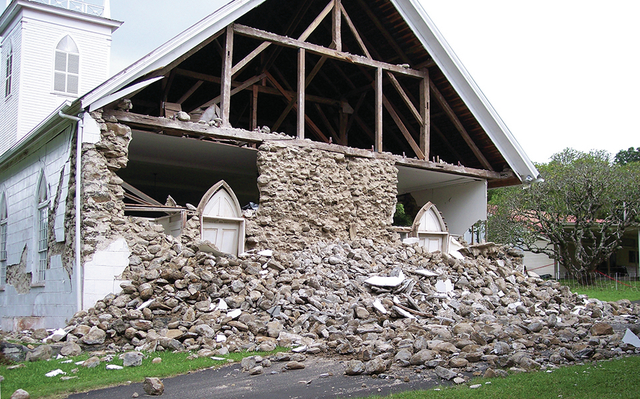Volcano Watch: Drop! Cover! Hold on! Protect yourself during Hawaii’s next earthquake

The state of Hawaii has a long history of destructive earthquakes. More than 30 magnitude-6 or greater earthquakes impacted the islands since 1868 (or about once every five years), and the chance of a damaging earthquake striking Hawaii in the next 10 years is 50 percent.
ADVERTISING
So, it’s a matter of when — not if — another destructive earthquake happens.
And, unlike tropical storms and hurricanes, which arrive with lots of advance notice, a large earthquake could strike at any time with no warning.
Given these facts, it’s essential you prepare now for Hawaii’s next big earthquake. Helpful guidance on preparing your home and workplace is available online through agencies such as FEMA (www.fema.gov/earthquake-safety-home).
Personal safety is another issue.
Knowing how to protect yourself and your family during an earthquake can prevent or minimize injuries (or worse).
First, what you should not do when the ground shakes: run outside or stand in a doorway. Although commonly thought to be appropriate responses, extensive research shows they are not the recommended actions to take.
Trying to run outside during an earthquake is more dangerous than staying inside a building because with the ground moving up and down or sideways, you easily could lose your balance and fall, risking serious injury. Also, exterior building walls and facades often collapse, so you’d be running toward danger rather than from it.
Doorways in modern buildings are no stronger than other parts of the structure, so they are not necessarily the safest places to be. They also provide little, if any, protection from flying debris or falling objects, the cause of most earthquake injuries.
So, what should you do to protect yourself during an earthquake?
According to earthquake safety experts, rescue teams and researchers, the best action you can take to reduce risk of injury or death during an earthquake is “Drop! Cover! Hold on!”
To keep from falling or being knocked down by the shaking, drop to the ground on your hands and knees. This position still will allow you to move if necessary.
To protect as much of your body as possible, especially your head and neck, take cover under a sturdy table or desk. If safe cover is not nearby, drop down next to an interior wall and cover your head and neck with your arms.
Then, hold on to your cover (table or desk) — or on to your head and neck if not under cover — until the shaking stops. This allows you to move with your cover if it shifts during the shaking.
If you’re at the beach, drop to your hands and knees and cover your head (if objects are falling) until the strong shaking stops. Then, quickly walk to higher ground until you’re at least 30 m (100 ft) above sea level, or beyond the marked tsunami hazard zone. Avoid steep cliffs and watch for falling rocks as you move inland.
What if you’re driving, asleep in bed, in a wheelchair or in a store when an earthquake hits? These scenarios are covered in “Recommended Earthquake Safety Actions in Hawaii” (www.shakeout.org/hawaii/downloads/ShakeOut_Hawaii_Recommended_Earthquake_Safety_Actions.pdf), which describes how to protect yourself during an earthquake wherever you are.
The key to personal safety is to practice now so you know exactly what to do — and can react quickly — when the next strong earthquake strikes Hawaii.
The perfect time to practice “Drop! Cover! Hold on!” is during the Great Hawaii ShakeOut, an earthquake awareness and preparedness event that takes place at 10:15 a.m. Oct. 15.
Details are posted on the ShakeOut website (http://shakeout.org/hawaii/), along with helpful resources on what you can, and should, do before, during and after an earthquake.
Additional resources are posted on the USGS Hawaiian Volcano Observatory (HVO) website (http://hvo.wr.usgs.gov/), including a slide show about the history of earthquakes in Hawaii. You also can call (808) 967-8802 or (808) 967-8844 for more information about the Great Hawaii ShakeOut and preparing for earthquakes.
On Oct. 15, HVO staff, along with more than 230,000 other Hawaii residents, will practice “Drop! Cover! Hold on!”
Whether you’re at home or at work, please join us. A few minutes of practice on that, or another, day could prevent injury or save your life during Hawaii’s next big earthquake.
Volcano activity update
Kilauea continues to erupt at its summit and East Rift Zone with no significant changes this past week.
The summit lava lake level varied between about 54 and 63 m (177–207 ft) below the vent rim within Halema‘uma‘u Crater. On the East Rift Zone, scattered lava flow activity remained within 7 km (4.3 mi) of Pu‘u ‘O‘o.
Mauna Loa is not erupting. During the past week, earthquake rates continued to be elevated, though at a lower weekly rate than previously recorded. Deformation data continued to indicate slight inflation of magma reservoirs within the volcano.
One earthquake was reported felt on the Big Island this past week. At 12:37 a.m. Sept. 25, a magnitude-3.4 earthquake occurred 14.8 km (9.2 mi) west of Kalapana at a depth of 7.3 km (4.6 mi).
Visit the HVO website (http://hvo.wr.usgs.gov) for past Volcano Watch articles, Kilauea daily eruption updates, Mauna Loa weekly updates, volcano photos, recent earthquakes info, and more; call for summary updates at 808-967-8862 (Kilauea) or 808-967-8866 (Mauna Loa); email questions to askHVO@usgs.gov.
Volcano Watch (http://hvo.wr.usgs.gov/volcanowatch/) is a weekly article and activity update written by scientists at the U.S. Geological Survey’s Hawaiian Volcano Observatory.


